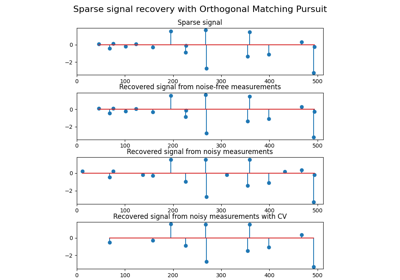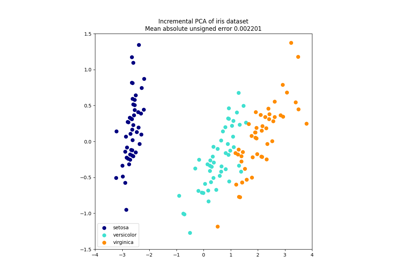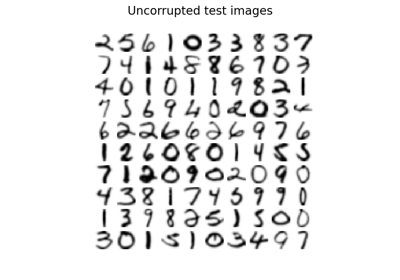Note
Go to the end to download the full example code. or to run this example in your browser via Binder
使用FastICA进行盲源分离#
一个从噪声数据中估计源的示例。
独立成分分析(ICA) 用于在给定噪声测量的情况下估计源。想象3个乐器同时演奏,3个麦克风记录混合信号。ICA用于恢复源,即每个乐器演奏的内容。重要的是,PCA在恢复我们的 乐器 时失败了,因为相关信号反映了非高斯过程。
生成示例数据#
import numpy as np
from scipy import signal
np.random.seed(0)
n_samples = 2000
time = np.linspace(0, 8, n_samples)
s1 = np.sin(2 * time) # Signal 1 : sinusoidal signal
s2 = np.sign(np.sin(3 * time)) # Signal 2 : square signal
s3 = signal.sawtooth(2 * np.pi * time) # Signal 3: saw tooth signal
S = np.c_[s1, s2, s3]
S += 0.2 * np.random.normal(size=S.shape) # Add noise
S /= S.std(axis=0) # Standardize data
# Mix data
A = np.array([[1, 1, 1], [0.5, 2, 1.0], [1.5, 1.0, 2.0]]) # Mixing matrix
X = np.dot(S, A.T) # Generate observations
拟合ICA和PCA模型#
from sklearn.decomposition import PCA, FastICA
# Compute ICA
ica = FastICA(n_components=3, whiten="arbitrary-variance")
S_ = ica.fit_transform(X) # Reconstruct signals
A_ = ica.mixing_ # Get estimated mixing matrix
# 我们可以通过还原解混过程来 `证明` ICA模型的适用性。
assert np.allclose(X, np.dot(S_, A_.T) + ica.mean_)
# 为了比较,计算PCA
pca = PCA(n_components=3)
H = pca.fit_transform(X) # Reconstruct signals based on orthogonal components
绘制结果#
import matplotlib.pyplot as plt
plt.figure()
models = [X, S, S_, H]
names = [
"Observations (mixed signal)",
"True Sources",
"ICA recovered signals",
"PCA recovered signals",
]
colors = ["red", "steelblue", "orange"]
for ii, (model, name) in enumerate(zip(models, names), 1):
plt.subplot(4, 1, ii)
plt.title(name)
for sig, color in zip(model.T, colors):
plt.plot(sig, color=color)
plt.tight_layout()
plt.show()

Total running time of the script: (0 minutes 0.180 seconds)
Related examples

sphx_glr_auto_examples_decomposition_plot_ica_vs_pca.py
二维点云上的快速独立成分分析




